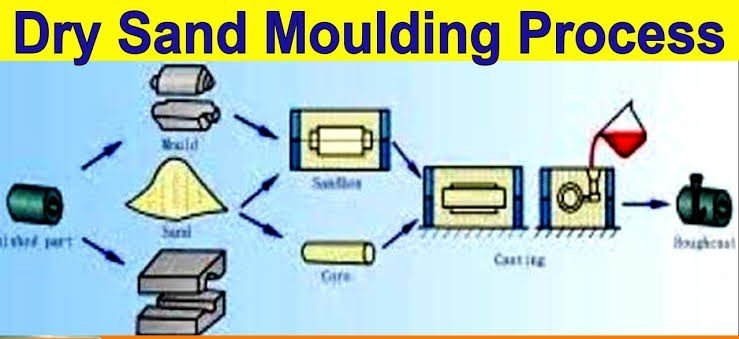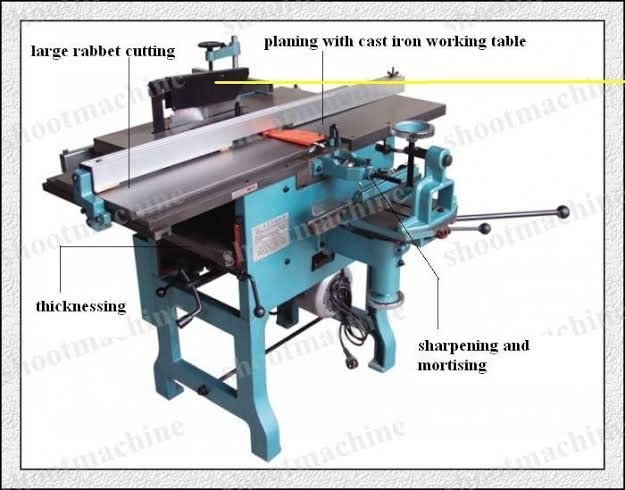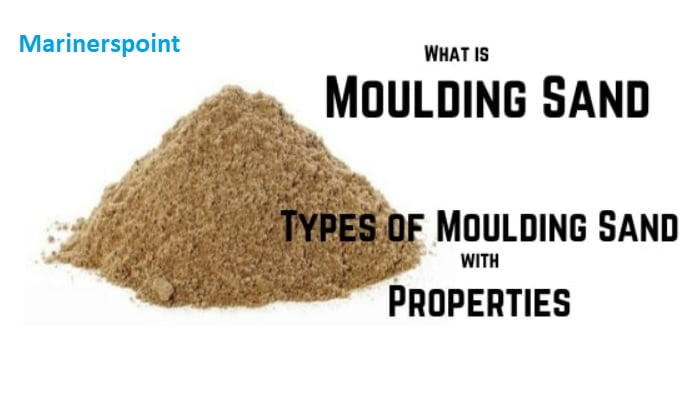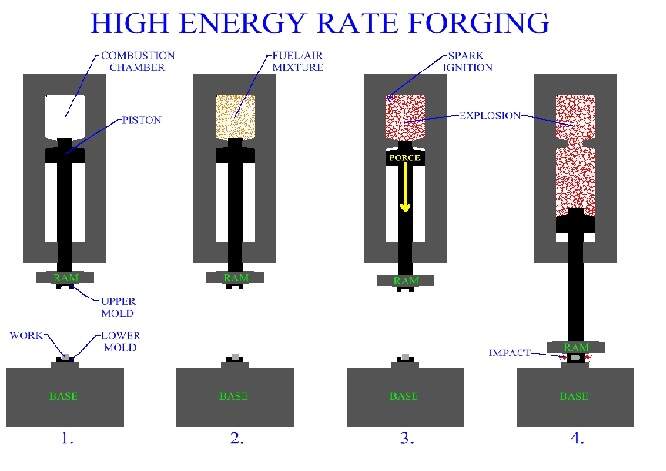In this article we will discuss about Moulding Process, types of moulding process classified on the basis of various terms like dry sand moulding, Green Sand moulding, Bench moulding etc.
Moulding process in common use may be classified according to different forms. They may broadly be classified as :
- Hand moulding, and
- Machine moulding.
In piece and, small-lot production foundry practice sand moulds are made by hand ; moulding machines are employed in Large-lot and mass production.
Types of Moulding Process
Moulding processes are often classified according to :
(A) The type of material of which the mould is made or
(1) Green sand moulds,
(2) Dry sand moulds,
(3) Skin-dried moulds,
(4) Loam moulds.
(B) The methods used in making the mould.
(1) Bench moulding,
(2) Floor moulding,
(3) Pit moulding,
(4) Sweep moulding, and
(5) Plate moulding.
Moulding Process based on Sand Used
1. Green Sand moulding

Green sand moulding is a versatile, quick, and low-cost method of creating moulds for high-quality ferrous and non-ferrous castings. Green sand is made up of silica sand, water, bentonite, and other additives, such as coal dust for iron applications.
Green-sand moulds are prepared with natural moulding sands or with mixtures of silica sand, bonding clay, and water. These materials are thoroughly mixed in proportions which will give the desired properties for the class of work being done.
2. Dry Sand Mould

The moulding process involved in making dry sand moulds are similar to those employed in green-sand moulding except that a different sand mixture is used and all parts of the mould are dried in an oven before being reassembled for casting.
The green sand mould depends upon the moisture and the natural clay binder in the sand to retain its shape. But the sand used for dry sand moulds depends upon added binding material such as flour, resin, molasses,or clay. The materials are thoroughly mixed and tempered with a thin clay water. The amount of binder is determined by the size of the casting being made.

3. Skin-dried Moulding
Skin dried Moulding process is a process that dries the moisture from the surface layer of the rammed sand to a depth of about 25 mm or more by using gas torches or heaters. It has the advantages of both green sand and dry sand moulding to a certain extent. Since the time required for drying is less than in the case of dry sand, the method is less expensive. Skin-drying is particularly adapted to very large moulds, or to works which require accurate details.
4. Loam Mould

Loam is clay and sand mixed with water to form a thin plastic mixture from which moulds are made. Loam sand also contains fire clay or ganisters. The loam must be sufficiently adhesive so that it can cling to the vertical surfaces. Loam moulds always require special provision to secure adequate ventilation. The object is to open out pores in the otherwise compact, closely knit mass, by artificial means. Thus various kinds of organic matter such as chopped straw, and particularly horse manure, is mixed up with the sand. A typical loam sand mixture is given below :
This is applied as plaster to the rough structure of the mould usually made of brickwork and the exact shape is given by a rotating sweep around a central spindle as shown in the figure. Cast iron plates and bars are used to reinforce the brickwork which retains the moulding material. Loam moulds may also be prepared by the use of a skeleton pattern made of wood. The surfaces of loams are blackened and are dried before being assembled.
Loam moulds are employed chiefly in the making of large castings for which it would be too expensive to use full patterns and ordinary flask equipment. Objects such as large cylinders, round-bottomed kettles, chemical pans, large gears, and other machine parts are produced in loam moulds.
Types of Moulding Process based on the Methods Used
1. Bench and Floor Moulding

Bench moulding applies chiefly to moulds small enough to be made on a work bench of a height convenient to the moulder.
Very heavy castings or castings of a considerable depth or area may be moulded in the sand of the foundry floor in much the same way as green-sand or dry-sand moulding. In such cases, the floor itself acts as the drag, and this may be covered with a cope or the mould may be cast open.
2. Pit Moulding

Pit Moulding Process : Moulds of large jobs are generally prepared in a pit dug in the foundry floor which facilitates in lifting the pattern and casting the mould easily. Since a pit which functions as a drag cannot be rolled over, the sand under the pattern may be rammed by bedded-in. The pattern may be suspended in correct location as the sand is rammed under it. In other cases, if the bottom surface of a pattern is flat, the pattern can be placed on a flat level surface rammed up for it.
A bed of coke is laid on the bottom of the pit, covered with straw and then a layer of sand, which is rammed and leveled. The coke bed is connected with atmosphere by vertical vent pipes in the corners of the pit to provide an outlet for the gases generated. If the floor is lightly damp, the inside surfaces of the pit are lined with tar-paper, bricks, or wooden planks. Generally, one box is required to complete the moulding process. Runners, pouring basins, feeders, are cut in it.
3. Sweep Moulding

Sweep mouldings are employed for moulding parts whose shape is that of a surface of revolution. In the preliminary process, a base 1 and spindle 2 is well placed in the foundry floor. The sand is filled in and rammed until the excavation forms approximately the shape and size of the required casting. This is illustrated in Figure a .
A sweep holder 5 is then placed in the spindle land the sweep 6 is attached by bolts and nuts. The surface of the mould is produced by the profile of the sweep as it is rotated about the spindle as shown in Figure (b). After sweeping, the spindle is removed and the mould patched at the centre. The gate is then cut and the mould is ready for pouring. This is shown in Fig. (c).
4. Plate Moulding

Plate Moulding Process : In this mounted parting process, the pattern is divided into half across the parting and in halves on to plates with parallel sides of the same shape as the figure. The use of plates gives the following advantages :
- The patterns can be handled easily and rapidly.
- The task of making the joint between the two parts of the mould is relieved as the plate provides its own joint when the flask is rammed up.
- The pattern can be drawn quickly, as the plate overlaps the side of the box and the pins which hold it in position act as guides during the drawing operation.
Some Special Moulding Processes
In recent years, special moulding processes have been developed to effect a saving in time and expense, to produce better quality moulds and cores, and to increase productivity with less effort and skill. Generally, these processes do not in all cases require drying or baking of moulds or cores, and rapid hardening action takes place due to chemical reactions in them. The use of following special moulding processes has considerably increased in recent years.
1. Carbon Dioxide Moulding

Carbon Dioxide Moulding Process : The process is basically a hardening process for moulds and cores. The principle of working of the CO2 process is based on the fact that if CO2 gas is passed through a sand mix containing sodium silicate (water glass), the sand immediately becomes extremely strongly bonded as the sodium silicate becomes a stiff gel. This gel is responsible for giving the necessary strength to the mould.
2. Ferro-silicon Moulding

Ferro-silicon Moulding : This moulding process is based on the principle that if sodium silicate and powdered ferro-silicon are mixed in the ratio of 2.25 : 1 by weight, foaming action takes place and the temperature rises by exothermic reaction between them. At room temperature, this reaction takes places slowly but once the temperature is increased, the reaction accelerates. Finally, the silica sand forms a hard spongy mass. No baking of the mould or core is necessary as in the CO2 process.
Normally, for ferrous casting clean, dry sand of 65 mesh, while for nonferrous casting, sand of 100 mesh is suitable. The moulds have to be coated with a suitable wash before they are closed.
3. Dicalcium Silicate Moulding
Dicalcium Silicate Moulding : This moulding process is based on the principle that if about 2-3 percent dicalcium silicate, known to be very effective hardening agent, and 5 percent sodium silicate are mixed with sand along with suitable foaming chemicals, flowability of sand mass increases. As a result, the sand mix can easily flow in the mould, and there is no need of ramming as required in conventional moulding process. Finally, the sand forms a hard mass having sufficient collapsibility
The main advantage of this moulding process is the great saving in labour input and moulding equipment since no drying or backing are needed. On the other hand, high quality defect-free castings are produced. This finds wide application in medium and heavy castings, both in grey iron and steel castings.
4. Cement-Sand Moulding
Cement-Sand Moulding : Portland cement may be used as binding material to bind sand grains together. It is found that a good combination of strength, permeability, and flowability is achieved by using cement along with sodium silicate. Flowable cement slurry can also be produced using foaming chemicals in the sand mix. The ramming of sand is thus considerably reduced. However, a good bond can be developed in sand with the addition of about 2 per cent 2 cement, 4-5 per cent sodium silicate, and 1 per cent pitch or molasses.
These moulds produce smooth and accurate surface, but the main disadvantage with cement bonded sand moulds is that they are difficult to knock out of the flask.
5. Shell Moulding

Shell Moulding : After the name of its inventor, the shell moulding is also known as Croning process or C-process. This is variant of the resin bonded sand technique for casting steel, iron or nonferrous alloys.
The mould is formed from a mixture of fine sand (100-150 mesh) and a thermosetting resin binder that is placed against a heated metal pattern, preferably made of grey cast iron. When the mixture is heated on this manner, the resin cures, causing the sand grains to adhere to each other forming sturdy shell that conforms exactly to the dimensions and shape of the pattern and constitutes half of a mould.
After the shell has been cured and stripped from the pattern, any cores required are set, the two halves of the mould are secured together, placed in a flask and backup material added ; then the mould is ready for pouring.
6. Hot and Cold Box Moulding
The hot-box process, particularly adapted in core making, uses basically the same materials as that used in shell moulding, but here the resin is applied for coating the sand grains. The resin-sand mix is then blown over the metal pattern or core box heated to about 200° to 300°C and allowed to form a solid mass instead of allowing shell formation.
Special hot-box machines are now available where the sand mix is blown over the heated pattern, the blown sand cured, and mould or core then stripped from the pattern or core box.
Greater accuracy of dimensions and higher rates of production than in the case of shell moulding are achieved. This is a moulding and core making process essentially for mechanised production of small casting required in big quantities.
The cold-box process consists of mixing fine dry sand either polyisocyanate resin binder and alkyd phenolic resin, blowing the mix into a sealed core box and injecting an airborne catalyst triethylamine vapour through the core box. The hydroxyl group of the liquid phenolic resin combines with the isocyanate group to form a stiff urethane resin. The two binder components are usually used in a 1:1 ratio with from 1 to 2 per cent by weight of the resin mixture added to the sand. a
The process has the advantage that no heating of pattern is required, and the curing takes place in only within 20-30 seconds. So it is a simple, high production core making process, and extremely suitable for small-sized castings required in large quantities.
7. Invest Moulding

Invest Moulding : This process of making casting is often referred to as “lost wax process” and “precision casting process”. Casting can be made to very close tolerances in this process and do not require subsequent machining.
It consists mainly of two stages which are shown in the figure. First, a master pattern is made of wood or metal around which a mould is formed. It does not consist of moulds sand but of gelatine or an alloy of low melting point which is poured over the master pattern. This master mould consists of the usual two section and can be opened. It is used for making the “lost pattern“.
8. Plaster Moulding
Plaster Moulding : In this method, the mould is prepared in gypsum or plaster of paris. In practice, the plaster of paris is mixed with talc, asbestos, fibres, silica flour, and a controlled amount of water to form a slurry. This plaster slurry is poured over the metallic pattern confined in a flask.
The mould is vibrated and the slurry allowed to set. The pattern is removed after about 30 minutes when the setting is complete and the mould is dried and backed by slowly heating it to about 200°C in a conveyor oven. Inserts and cores are placed, cope and drag matched by guide pins. Molten metal is then poured into the mould. Finally, the casting is cooled in the mould, shaken out and the mould is destroyed. Castings are then trimmed of gates, sprues, and flash.
9. Ceramic Moulding
In ceramic moulding process, a thick slurry, consisting of specially developed ceramic aggregates and a liquid chemical binder (alcohol based silicon ester) is pured over the reusable split and gated metal pattern which is usually mounted on a match plate. The slurry fills up all cavities and recesses by itself and no ramming or vibration of the mould is required. The pattern is withdrawn after it sets in about 3 to 5 minutes. The ceramic mass is then removed from the flask, treated with a hardener to promote chemical stabilization and heated to about 980°C in a furnace to remove the liquid binder. The mould is then ready for pouring molten metal.
10. Suction Moulding
Suction Moulding Process : In this method, a vacuum is created by withdrawing air from the mould space. Subsequently moulding sand is sucked in, and the cavity is filled up. The sand can thereafter be rammed in the pattern. The processes is used for casting iron, steel and aluminium.
We tried to cover all the important point relating to the Moulding Process and its types and classifications. Hope you enjoyed this article. Please provide your feedback in the comment below.
Check Out Other Important Topics
Foundry Tools And Equipment – List, Names & Images
Sand Testing Methods – Full Process
Types of Casting Defects – Complete Overview
Moulding Sand – Properties, Types, Process, MCQs
Plant Layout – Types, Objectives, Principles, Advantages
Types of Punches – Uses, Working, Applications, Pictures
Types of Dies – Classification, Uses, Pictures
Types of Rivets – Working & Their Uses [with Images]
Types of Fasteners – Uses & Examples [with Pictures]
| IC Engine | Important PDFs | Boilers | Synergy Maritime Exam | Naval Arch | MEO Class 4 |
| Interview Questions | Difference Between | Types of Pumps | Auxiliary Machines | Types of Valves | Home |



